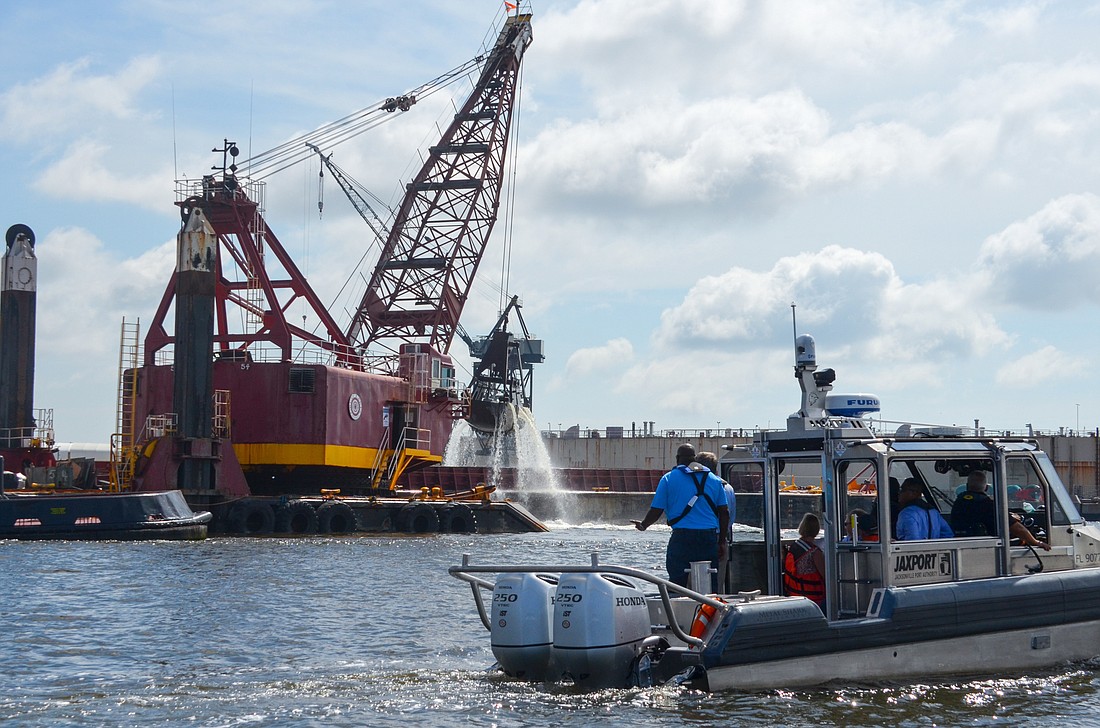
The Jacksonville City Council authorized a $70 million city contribution and $40 million bridge loan to the Jacksonville Port Authority’s dredging project in the St. Johns River.
Council voted 17-0 on July 28 to enact Ordinance 2020-377, which includes a $35 million grant and the bridge loan to be used in the final contract for a $484 million, 11-mile portion of the Jacksonville harbor deepening project.
The bill commits the city to another $25 million grant in the fiscal year 2020-21 budget with the option to increase that amount by $10 million if needed, according to a summary filed with the legislation.
JaxPort’s total plan will deepen the 13-mile shipping channel from 40 to 47 feet from the Atlantic Ocean to the Dames Point Marine Terminal. The project is divided into four segments.
The ordinance enacted July 28 is for the project through the Blount Island Marine Terminal, which is east of the Dames Point terminal.
The project began in February 2018 and is anticipated to be completed in 2023, two years ahead of schedule, based on continued funding.
The new depth can accommodate the large post-Panamax ships from Asia passing through the enlarged Panama Canal.
The city will borrow the money to finance its contribution. City CFO Patrick “Joey” Grieve told Council members in committee hearings last week that the $35 million grant would be debt-funded by bond issuance before Oct. 1.
Grieve said the $40 million for the bridge loan will be financed by the city’s commercial paper program, a short-term liquidity loan option.
The port will repay the loan with interest using $46.1 million awarded to JaxPort by the state of Florida.
An agreement filed with the bill requires the port to pay for overruns in project costs.
JaxPort CFO Beth McCague said July 28 that COVID-19 slowed talks with city officials about the financial contribution to the dredging project.
The port has until Aug. 20 to secure and submit the funding to the U.S. Army Corps of Engineers, the project developer. JaxPort CEO Eric Green said meeting the deadline will ensure roughly $56 million in President Donald Trump’s 2020 budget for the dredging isn’t shifted to another project.
Green told the Council Neighborhoods, Community Services, Public Health and Safety Committee on July 20 that dredging equipment located and operating in the harbor now could significantly reduce bid costs on the next stage of the project.
“I will tell you on a project this size, for the last part of this contract, if those assets were to leave the harbor, we could be anticipating as much as a $15 to $20 million increase just on mobilization costs alone,” Green said.
In total, JaxPort says the federal government, state of Florida, the port and port tenant SSA Jacksonville have contributed or pledged a combined total of more than $394 million toward the $484 million deepening project.
Environmental impact
The project is not supported by the St. Johns Riverkeeper, a nonprofit research and policy organization that monitors the waterway’s ecological health.
During the July 20 committee hearing, Riverkeeper Lisa Rinaman referenced the Army Corps’ findings that the project will increase water levels up to 8.4 inches in some areas during 100-year storms.
Army Corps Biologist Mike Hollingsworth said that water level rise would impact “discrete areas” like Blount Island Terminal at JaxPort, the mouth of the Trout River and the Timucuan Ecological & Historical Preserve.
Hollingsworth said the project would not increase flooding in areas impacted by Hurricane Irma in 2017.
A federal judge ruled in May the dredging can continue and rejected arguments made in a lawsuit filed by the Riverkeeper that deepening the channel would impact wetlands and the increase in salinity would harm ecosystems, Daily Record news partner News4Jax reported May 28.
“Any of you representing low-lying areas know that inches truly matter, and the bottom line is the dredging will harm our river and it will make our community more vulnerable to future storms and flooding,” Rinaman said.
Hollingsworth said the Army Corps will collect data on the ecological and storm surge impact of the dredging project at five years and 10 years after completion.
Council member Randy DeFoor, who chairs the Council’s Special Resiliency Committee, said July 28 she seeks a commitment from JaxPort to provide mitigation dollars, if necessary.